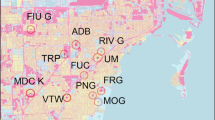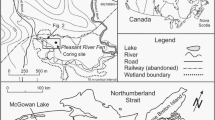Abstract
Freshwater turtles face many threats, including habitat loss and river regulation reducing occupancy and contributing to population decline. Limited knowledge of hydrological conditions required to maintain viable turtle populations in large floodplain wetlands hinders effective adaptive management of environmental water in regulated rivers. We surveyed three turtle species over 4 years across the Lower Murrumbidgee River floodplain, a large wetland complex with a long history of water resource development. Using site and floodplain metrics and generalized linear models, within a Bayesian Model Averaging framework, we quantified the main drivers affecting turtle abundance. We also used a hierarchical modeling approach, requiring large sample sizes, quantifying possible environmental effects while accounting for detection probabilities of the eastern long-necked turtle (Chelodina longicollis). The three species varied in their responses to hydrological conditions and connectivity to the main river channel. Broad-shelled turtles (Chelodina expansa) and Macquarie River turtles (Emydura macquarii macquarii) had restricted distributions, centered on frequently inundated wetlands close to the river, whereas the eastern long-necked turtles were more widely distributed, indicating an ability to exploit variable habitats. We conclude that turtle communities would benefit from long-term management strategies that maintain a spatiotemporal mosaic of hydrological conditions. More specifically, we identified characteristics of refuge habitats and stress the importance of maintaining their integrity during dry periods. Neighboring habitats can be targeted during increased water availability years to enhance feeding and dispersal opportunities for freshwater turtles.







Similar content being viewed by others
References
Arthington AH (2012) Environmental flows: saving rivers in the third millennium. University of California Press, Berkley, Vol. 4
Arthington AH, Balcombe SR (2011) Extreme flow variability and the “boom and bust” ecology of fish in arid-zone floodplain rivers: a case history with implications for environmental flows, conservation and management. Ecohydrology 4:708–720. doi:10.1002/eco.221
Ashton DT, Bettaso JB, Welsh HH (2015) Changes across a decade in size, growth, and body condition of western pond turtle (Actinemys marmorata) populations on free-flowing and regulated forks of the Trinity river in Northwest California. Copeia 103:621–633. doi:10.1643/cp-15-253
Bino G, Kingsford RT, Porter J (2015) Prioritizing wetlands for waterbirds in a boom and bust system: waterbird refugia and breeding in the Murray–Darling Basin. PLoS ONE 10 10.1371/journal.pone.0132682.
Bodie JR (2001) Stream and riparian management for freshwater turtles. J Environ Manage 62:443–455. doi:10.1006/jema.2001.0454
Bodie JR, Semlitsch RD (2000) Spatial and temporal use of floodplain habitats by lentic and lotic species of aquatic turtles. Oecologia 122:138–146. doi:10.1007/pl00008830
Bohm M et al. (2013) The conservation status of the world’s reptiles. Biol Conserv 157:372–385. doi:10.1016/j.biocon.2012.07.015
BOM (2016) Bureau of meteorology. http://www.bom.gov.au/climate/data/. Accessed 1 March 2016
Bower D, Hodges K (2014) Chelodina expansa Gray 1857–broad-shelled turtle, giant snake-necked turtle. Chelonian Res Monogr 5:71.71–81.71
Bower DS, Hutchinson M, Georges A (2012) Movement and habitat use of Australia’s largest snake-necked turtle: implications for water management. J Zool 287:76–80. doi:10.1111/j.1469-7998.2011.00891.x
Bowne DR, Bowers MA, Hines JE (2006) Connectivity in an agricultural landscape as reflected by interpond movements of a freshwater turtle. Conserv Biol 20:780–791. doi:10.1111/j.1523-1739.2006.00355.x
Chandler RB, Royle JA, King DI (2011) Inference about density and temporary emigration in unmarked populations. Ecology 92:1429–1435
Chessman BC (1984a) Evaporative water-loss from three south-eastern Australian species of fresh-water turtle. Aust J Zool 32:649–655. doi:10.1071/zo9840649
Chessman BC (1984b) Food of the snake-necked turtle, Chelodina longicollis (Shaw) (Testudines, Chelidae) in the Murray Valley, Victoria and New South Wales. Aust Wildlife Res 11:573–578
Chessman BC (1988) Habitat preferences of fresh-water turtles in the Murray Valley, Victoria and New South Wales. Aust Wildlife Res 15:485–491
Chessman BC (2011) Declines of freshwater turtles associated with climatic drying in Australia’s Murray–Darling Basin. Wildlife Res 38:664–671. doi:10.1071/wr11108
Commonwealth of Australia (2013) Commonwealth environmental water—monitoring, evaluation, reporting and improvement framework vol V2.0. Commonwealth Environmental Water Holder for the Australian Government
Cosentino BJ, Schooley RL, Phillips CA (2010) Wetland hydrology, area, and isolation influence occupancy and spatial turnover of the painted turtle, Chrysemys picta Landsc Ecol 25:1589–1600. doi:10.1007/s10980-010-9529-3
De Lathouder R, Jones DN, Balcombe SR (2009) Assessing the abundance of freshwater turtles in an Australian urban landscape. Urban Ecosyst 12:215–231
Francis R (2015) Do turtles respond to environmental flows? Honours Thesis, University of New South Wales
Georges A, Thomson S (2010) Diversity of Australasian freshwater turtles, with an annotated synonymy and keys to species. Zootaxa 2496: 1–37
Gibbons JW et al. (2000) The global decline of reptiles, Deja Vu amphibians. Bioscience 50:653–666. doi:10.1641/0006-3568(2000)050[0653:tgdord]2.0.co;2
Guillera-Arroita G, Lahoz-Monfort JJ, MacKenzie DI, Wintle BA, McCarthy MA (2014) Ignoring imperfect detection in biological surveys is dangerous: a response to “fitting and interpreting occupancy models”. PLoS ONE 9. doi:10.1371/journal.pone.0099571.
Hoeting JA, Madigan D, Raftery AE, Volinsky CT (1999) Bayesian model averaging: a tutorial. Stat Sci 14:382–401
Huey RB (1982) Temperature, physiology, and the ecology of reptiles. In: Gans, Carl, Pough, F. Harvey (eds) Biology of the reptilia. Academic Press, London, New York.
Hunt SD, Guzy JC, Price SJ, Halstead BJ, Eskew EA, Dorcas ME (2013) Responses of riparian reptile communities to damming and urbanization. Biol Conserv 157:277–284. doi:10.1016/j.biocon.2012.08.035
Kennett R, Roe J, Hodges K, Georges A (2009) Chelodina longicollis (Shaw 1784)–eastern long-necked turtle, common long-necked turtle, common snake-necked turtle. Chelonian Res Monogr 5:31.31–31.38
Kennett RM, Georges A (1990) Habitat utilization and its relationship to growth and reproduction of the eastern long-necked turtle, Chelodina longicollis (Testudinata, Chelidae), from Australia. Herpetologica 46:22–33
King A, Ward K, O’Connor P, Green D, Tonkin Z, Mahoney J (2010) Adaptive management of an environmental watering event to enhance native fish spawning and recruitment. Freshw Biol 55:17–31
Kingsford R (2003) Ecological impacts and institutional and economic drivers for water resource development—a case study of the Murrumbidgee River, Australia. Aquat Ecosyst Health Manag 6:69–79
Kingsford R, Georges A, Unmack P (2006) Vertebrates of desert rivers: meeting the challenges of temporal and spatial unpredictability. In: Kingsford RT (ed) Ecology of desert rivers. Cambridge University Press, Cambridge, pp 154–200
Kingsford RT (2000) Ecological impacts of dams, water diversions and river management on floodplain wetlands in Australia. Austral Ecol 25:109–127. doi:10.1111/j.1442-9993.2000.tb00012.x
Kingsford RT, Brandis K, Thomas RF, Crighton P, Knowles E, Gale E (2004) Classifying landform at broad spatial scales: the distribution and conservation of wetlands in New South Wales, Australia. Mar Freshwater Res 55:17–31. doi:10.1071/mf03075
Kingsford RT, Thomas RF (2004) Destruction of wetlands and waterbird populations by dams and irrigation on the Murrumbidgee River in arid Australia. Environ Manage 34:383–396. doi:10.1007/s00267-004-0250-3
Marchand MN, Litvaitis JA (2004) Effects of habitat features and landscape composition on the population structure of a common aquatic turtle in a region undergoing rapid development. Conserv Biol 18:758–767. doi:10.1111/j.1523-1739.2004.00019.x
Meador MR, Carlisle DM (2012) Relations between altered streamflow variability and fish assemblages in eastern USA streams. River Res Appl 28:1359–1368. doi:10.1002/rra.1534
New South Wales Government (2008) RiverBank Water Use Plan for the Murrumbidgee water management area. http://www.environment.nsw.gov.au/resources/environmentalwater/wup-murrumbidgee.pdf
Pappas MJ, Brecke BJ (1992) Habitat selection of juvenile Blanding’s turtles, Emydoidea blandingii. J Herpetol 26:233–234
Parmenter C (1985) Reproduction and survivorship of Chelodina longicollis (Testudinata: Chelidae). In: Grigg G, Shine R, Ehmann H (eds) Biology of Australasian frogs and reptiles. Chipping Norton, N.S.W: Surrey Beatty in association with The Royal Zoological Society of New South Wales, pp 53–61
Poff NL, Zimmerman JKH (2010) Ecological responses to altered flow regimes: a literature review to inform the science and management of environmental flows. Freshw Biol 55:194–205. doi:10.1111/j.1365-2427.2009.02272.x
R Core Team (2014) A language and environment for statistical computing. R Foundation for Statistical Computing, Vienna
Raftery AE, Hoeting JA, Volinsky CT, Painter I, Yeung KY (2011) Bayesian model averaging. R package version 3.14.1 (R Development Core Team). http://cran.r-project.org/web/packages/BMA/index/html
Rees M, Roe JH, Georges A (2009) Life in the suburbs: behavior and survival of a freshwater turtle in response to drought and urbanization. Biol Conserv 142:3172–3181. doi:10.1016/j.biocon.2009.08.019
Robertson AI, Bacon P, Heagney G (2001) The responses of floodplain primary production to flood frequency and timing. J Appl Ecol 38:126–136. doi:10.1046/j.1365-2664.2001.00568.x
Roe JH, Brinton AC, Georges A (2009) Temporal and spatial variation in landscape connectivity for a freshwater turtle in a temporally dynamic wetland system. Ecol Appl 19:1288–1299. doi:10.1890/08-0101.1
Roe JH, Georges A (2007) Heterogeneous wetland complexes, buffer zones, and travel corridors: landscape management for freshwater reptiles. Biol Conserv 135.1:67–76
Roe JH, Georges A (2008b) Terrestrial activity, movements and spatial ecology of an Australian freshwater turtle, Chelodina longicollis, in a temporally dynamic wetland system. Austral Ecol 33:1045–1056. doi:10.1111/j.1442-9993.2008.01877.x
Roe JH, Georges A, Green B (2008) Energy and water flux during terrestrial estivation and overland movement in a freshwater turtle. Physiol Biochem Zool 81:570–583. doi:10.1086/589840
Rosenberg DK, Swift R (2013) Post-emergence behavior of hatchling western pond turtles (Actinemys marmorata) in Western Oregon. Am Midl Nat 169:111–121
Royle JA (2004) N-mixture models for estimating population size from spatially replicated counts. Biometrics 60:108–115. doi:10.1111/j.0006-341X.2004.00142.x
Royle JA, Nichols JD (2003) Estimating abundance from repeated presence-absence data or point counts. Ecology 84:777–790. doi:10.1890/0012-9658(2003)084[0777:eafrpa]2.0.co;2
Spencer R (2001) The Murray River turtle, Emydura macquarii: population dynamics, nesting ecology and impact of the introduced red fox, Vulpes vulpes. Dissertation, University of Sydney
Spencer RJ, Thompson MB (2005) Experimental analysis of the impact of foxes on freshwater turtle populations. Conserv Biol 19:845–854. doi:10.1111/j.1523-1739.2005.00487.x
Spencer RJ, Thompson MB, Hume ID (1998) The diet and digestive energetics of an Australian short-necked turtle, Emydura macquarii. Comp Biochem Phys A 121:341–349. doi:10.1016/s1095-6433(98)10132-0
Stott P (1987) Terrestrial movements of the fresh-water tortoise Chelodina longicollis shaw as monitored with a spool tracking device. Wildlife Res 14:559–567
Thomas RF, Kingsford RT, Lu Y, Cox SJ, Sims NC, Hunter SJ (2015) Mapping inundation in the heterogeneous floodplain wetlands of the Macquarie Marshes, using Landsat Thematic Mapper. J Hydrol 524:194–213. doi:10.1016/j.jhydrol.2015.02.029
Tucker AD, Limpus CJ, Priest TE, Cay J, Glen C, Guarino E (2001) Home ranges of Fitzroy River Turtles (Rheodytes leukops) overlap riffle zones: potential concerns related to river regulation. Biol Conserv 102:171–181. doi:10.1016/s0006-3207(01)00097-0
Ummenhofer CC et al. (2009) What causes southeast Australia’s worst droughts? Geophys Res Lett 36. doi:10.1029/2008gl036801
Van Dijk PP, Iverson JB, Rhodin AG, Shaffer HB, Bour RJ (2014) Turtles of the world, 7th edition: annotated checklist of taxonomy, synonymy, distribution with maps, and conservation status. In: Rhodin AG, Pritchard PCH, Van Dijk PP, Saumure RA, Buhlmann KA, Iverson JB, Mittermeier RA (eds) Conservation biology of freshwater turtles and tortoises: a compliation project of the IUCN/SSC tortoise and freshwater turtle specialist group, Chelonian Res Monogr 5(7):329–479. doi:10.3854/crm.5.000.checklist.v7.2014
Wintle BA, McCarthy MA, Volinsky CT, Kavanagh RP (2003) The use of Bayesian model averaging to better represent uncertainty in ecological models. Conserv Biol 17:1579–1590. doi:10.1111/j.1523-1739.2003.00614.x
Acknowledgements
Funding for the wetland surveys was provided by the NSW Government and Australian Government’s Water for the Future—Water Smart Australia Program through the Rivers Environmental Restoration Program (RERP) (2008–2010), NSW Catchment Action Program (2010–2011), and Commonwealth Environmental Water Holder Short-term Intervention Monitoring Program (2013–2014). We thank numerous field assistants, including Richard Allman and Erin Lenon, Simon Hunter for distance calculations, and James Maguire for commenting on water management in the Murrumbidgee. The authors of this paper respectfully acknowledge the traditional owners, their Elders past and present, their Nations of the Murray–Darling Basin, and their cultural, social, environmental, spiritual, and economic connection to their lands and waters. In particular the Wiradjuri, Narri Narri, and Muthi Muthi peoples, traditional owners of the land on which this publication is focused. The 2008–2011 field surveys were approved under NSW National Parks and Wildlife Service Scientific Licence S13080 and S12700, NSW Fisheries license F89/1598, and NSW Animal Ethics Committee approval ACEC 06/08. The 2013–2014 field surveys were approved under NSW National Parks and Wildlife Service Scientific Licence 100441, NSW Fisheries license P11/0043-11, and Charles Sturt University Animal Care and Ethics Committee 13/059.
Author information
Authors and Affiliations
Corresponding author
Ethics declarations
Conflict of Interest
The authors declare that they have no conflict of interest.
Electronic supplementary material
Rights and permissions
About this article
Cite this article
Ocock, J., Bino, G., Wassens, S. et al. Identifying Critical Habitat for Australian Freshwater Turtles in a Large Regulated Floodplain: Implications for Environmental Water Management. Environmental Management 61, 375–389 (2018). https://doi.org/10.1007/s00267-017-0837-0
Received:
Accepted:
Published:
Issue Date:
DOI: https://doi.org/10.1007/s00267-017-0837-0




